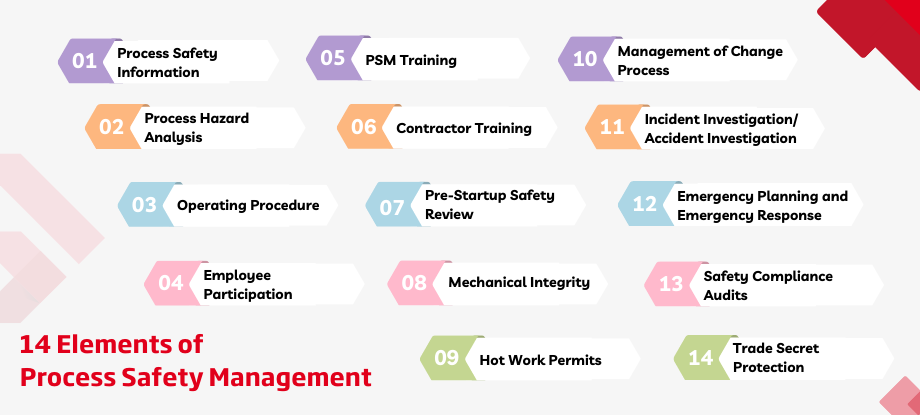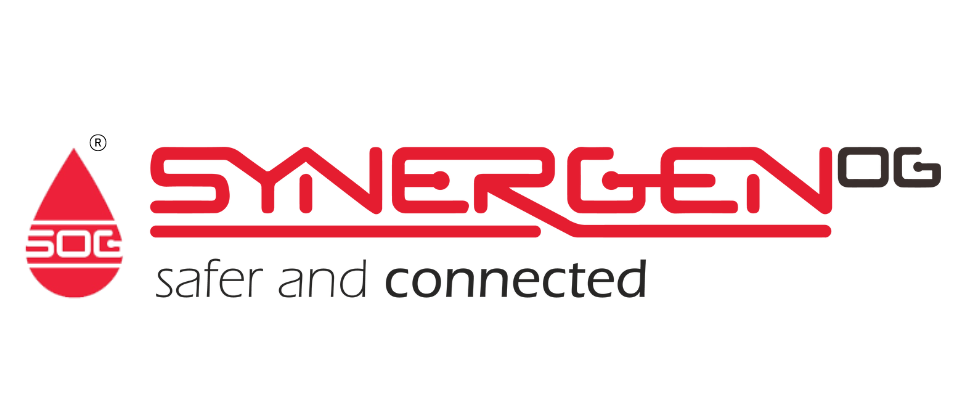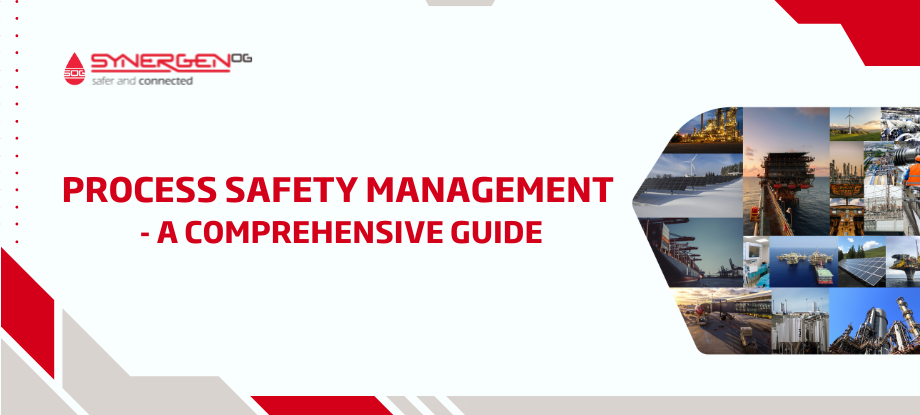Process safety management is a critical part of keeping your business safe. Implementing a strong process safety management system can help you avoid accidents and protect your workers, your business, and the environment.
In this article, we’ll cover what process safety is, the benefits of process safety management, and the 14 essential elements of a successful PSM system.
Process Safety – The Definition
When people hear the term “process safety,” they think of chemical plants and oil refineries. But process safety is actually a term that applies to any process where there’s a potential for harm.
For example, let’s say you’re running a bakery. The process of making bread involves mixing yeast, flour and water, and if something goes wrong with that mixture, you could end up with an explosion. That’s why it’s important to have a process safety management plan in place so that you can identify and mitigate any risks before they cause harm.
Process safety is the prevention of uncontrolled releases of hazardous materials and energy. The goal of process safety is to protect people, equipment, and the environment from the consequences of these releases.
Process safety is a relatively new field, born from the industrial accidents at Bhopal, India, in 1984 and Piper Alpha in 1988. These accidents highlighted the need for better management of process safety risks.
3 Key Aspects of Process Safety
Process Safety is a critical aspect of any organization that deals with hazardous materials. It is important to have a clear understanding of the three key aspects of process safety to manage the risks associated with these materials effectively.
The three key aspects of process safety are:
1. Inherently Safer Design
This aspect of process safety deals with designing products and processes so that they are less likely to fail or release hazardous materials. Inherently safer design principles seek to minimize the potential for human error and reduce the consequences of accidents.
2. Engineering Controls
Engineering Controls are used to manage the hazards associated with processes and materials. These controls include process isolation, process automation, and emergency shutdown systems.
3. Disciplined Operating Practices
Disciplined Operating Practices help to ensure that processes are operated safely and within their design parameters. These practices include standard operating procedures, training, and regular maintenance.
By understanding and managing these three key aspects of process safety, organizations can effectively reduce the risks associated with hazardous materials.
Process Safety Management – The Purpose
Today, process safety is an integral part of managing the risks associated with using hazardous materials and energy. Process safety covers a wide range of topics, from the design of safe facilities to the management of unsafe conditions.
Simply put, PSM is a system that helps organizations manage risks associated with their processes. It’s all about preventing accidents and incidents from happening in the first place. That way, you’re not just putting your workers at risk—you’re also risking the environment and the community at large.
The 14 elements of process safety management are designed to make sure that all of those factors are accounted for.
What are the 14 Elements of PSM?

Let’s take a look now at the 14 elements of process safety management. These are the basic foundation you need to have in place to manage the safety of your processes.
Each of these elements is important, and you must ensure that you’re addressing them all to create a safe working environment.
- Process Safety Information
- Process Hazard Analysis
- Operating Procedure
- Employee Participation
- Process Safety Management Training
- Contractor Training
- Pre-Startup Safety Review
- Mechanical Integrity
- Hot Work Permits
- Management of Change Process
- Incident Investigation/Accident Investigation
- Emergency Planning and Emergency Response
- Safety Compliance Audits
- Trade Secret Protection
OSHA Standards on Process Safety Management
The Occupational Safety and Health Administration is a federal agency that helps protect workers from exposure to dangerous conditions. OSHA sets and enforces standards for safety in the workplace, and provides training and education programs on process safety to help employers and employees stay safe.
In order to ensure the safety of workers and the public, OSHA has established a set of standards for process safety management (PSM). This includes procedures and practices for the safe handling of hazardous materials.
The key to PSM is identifying and controlling hazards before they can cause an accident. To do this, PSM programs must address all aspects of process safety, from design and construction to operation and maintenance.
PSM programs must also include provisions for emergency response in the event of an accident. This may include evacuating workers and the public from the area, as well as providing medical treatment.
To be effective, PSM programs must be tailored to the specific needs of each facility. They must be regularly reviewed and updated to keep up with changes in the facility and its operations.
How To Develop PSM Framework
Your organization’s process safety management framework needs to be tailored to your needs. But in general, it should include the following:
1) Process Safety Culture – You need to create a culture where everyone in the organization is aware of and takes responsibility for process safety. This means developing policies and procedures that are clear and easy to follow and training employees on how to operate equipment and handle hazardous materials safely.
2) Identify & Assess Risks – You need to identify potential hazards and assess the risks they pose to employees, the environment, and the community. This includes conducting hazard identification studies and risk assessments and implementing controls to mitigate those risks.
3) Management of Risks – Once you’ve identified and assessed the risks, you need to establish a management system. This includes developing emergency response plans, tracking incident trends, and periodically reviewing your safety program to ensure it’s still effective.
Two Famous Process Safety Models
There are two famous process safety models that are widely used in the process industries. They are known as the Swiss Cheese Model and the Risk-based model.
#1. The Swiss Cheese Model of Process Safety
The Swiss Cheese Model of Process Safety is a great analogy for understanding how process safety works.
Basically, the model likens the organizational structure of process safety to a stack of Swiss cheese slices. Each slice is a layer of protection, and if one layer fails, the cheese still holds together.
This Swiss cheese model is a great way to visualize how different parts of an organization work together to create a safe system. And it’s also useful for understanding where improvements can be made.
If you’re interested in learning more about process safety, SynergenOG Academy offers courses that will teach you everything you need to know.
#2. The Risk-Based Model of Process Safety by CCPS
The Center for Chemical Process Safety (CCPS) has developed a risk-based approach to process safety management (PSM). The CCPS Risk Based model is a holistic approach that considers all aspects of process safety, from the initial design of the process through to its eventual decommissioning.
The model considers both the technological and human factors that can contribute to process hazards. By using this model, organizations can effectively identify and control process safety risks.
The idea behind the risk-based model is that you can’t prevent all incidents, but you can manage the risks so that the chances of an incident happening are reduced. To do this, you need to understand the hazards associated with your process and how serious they could be if they were to occur.
Developing A PSM Model
There are four types of Process Safety Management (PSM) models: Standards-Based, Compliance-Based, Continuous Improvement-Based, and Risk-Based. Each has its advantages and disadvantages, and it’s important to choose the right model for your business.
Standards-Based PSM is based on compliance with industry standards such as OSHA’s Process Safety Management Standard. This model is for companies that want a framework to follow and don’t have the resources to develop their PSM program.
Compliance-Based PSM is based on meeting specific safety requirements set by the organization. This model is for companies that have had a previous incident and are looking to improve their safety performance.
Continuous Improvement-Based PSM is based on a continuous improvement cycle of identifying, planning, doing, checking, and acting. This model is for companies that want to be proactive about safety and are always looking to improve.
Risk-Based PSM is based on risk assessment and management. This model is for companies that want to focus on areas with the highest potential for harm.
How To Implement Process Safety Management
Ok, so you’re convinced that process safety is important. Great! But now you’re probably wondering: how do I actually go about implementing process safety management in my business?
The first step is to conduct a risk assessment. This will help you identify any potential hazards and come up with measures to mitigate those risks.
Once you have a clear understanding of the risks involved, you need to put in place some safety protocols and procedures. These should be tailored to your specific business and should be reviewed and updated regularly.
Finally, it’s important to make sure that everyone in your organization is aware of the importance of process safety and knows how to operate your systems and processes safely. Training and awareness programs are essential for ensuring compliance with safety standards.
How Can SynergenOG Help With Process Safety Management?
Process safety management is a critical aspect of any company that handles hazardous materials. But implementing a process safety management plan can be difficult especially if you’re not sure where to start.
That’s where SynergenOG comes in. We’re a client-centric organization dedicated to bringing about a step change in process safety and creating greater awareness in the energy industry.
We can help you with a detailed process safety review and develop a process safety management plan that meets all of your specific needs. We use a disciplined framework for managing the integrity of operating systems and processes.
To Conclude, Why Is Process Safety So Important?
Put simply, if something goes wrong, the consequences can be catastrophic. Just look at the oil and gas industry — it’s littered with examples of accidents that have cost lives and caused billions of dollars in damage.
Process safety is about preventing accidents from happening in the first place. And it’s essential for any business that deals with hazardous materials. If you’re not confident in your ability to manage process safety, then it’s worth considering hiring a company like SynergenOG to help you out.
PSM - Frequently Asked Questions
- What is meant by process safety?
Process safety is a disciplined framework for managing the integrity of operating systems and
processes that handle hazardous substances by relying on good design principles, engineering,
and operating and maintenance practices. - What does Process Safety Management (PSM) mean in safety?
Process Safety Management addresses the safety measures required to prevent accidental release of hazardous material from its containment such as vessel, piping and tank. Process Safety Management is a structured and proactive risk-based approach which uses implementation techniques to manage process safety risks.
- What is Process Safety and why it is so important?
Process safety deals with large scale and catastrophic workplace risks with major consequences, including fatalities, injuries, property damage, lost production, or environmental damage. It investigates the events that have potential to release hazardous materials and energy.
Process safety is important to prevent catastrophic events and help reduce the occurrence of a major accident - What is the purpose of Process Safety Management (PSM)?
The objective of process safety management is to ensure that potential hazards are identified, and mitigation measures are in place to prevent unwanted releases of energy or hazardous chemicals into locations that could expose workers to serious injuries or fatalities.
- What are the three key aspects of process safety?
Process safety is about managing the integrity of operating systems by applying inherently safer design principles, engineering and disciplined operating practices.
- What are process safety risks?
Potential hazardous events that arise from unwanted conditions /chemical processes, i.e., fire, explosions, toxic gas releases, dust, etc. comes under process safety risks.
- What is Process Safety Fundamentals?
Process safety fundamentals are guidelines that emphasize good practices that would help prevent the occurrence of a major accident. These guidelines are applicable to everyone working with a hazardous material from management to the workforce.


[…] Process Safety Management – A Comprehensive Guide […]
[…] plays a vital role in the effective implementation of process safety management. It ensures clear communication of safety procedures, standardization of processes, and provides […]